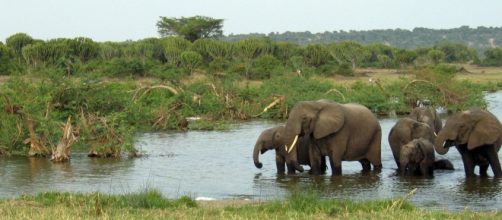The Great Elephant Census in Africa is in full swing. The good news is that the Wildlife Conservation Society (WCS), working with the Uganda Wildlife Authority (UWA) has completed an aerial survey, which shows that Ugandan elephant numbers have increased significantly since the 1980's.
Elephants in Uganda were estimated to number between seven hundred to eight hundred individuals during the 1980’s, but the recent count indicates the population is now about five thousand.
The areas surveyed did not include all protected areas, such as the Maramagambo forest within Queen Elizabeth National Park.
Uganda has sixty protected wildlife areas, the total size of which is greater than twenty thousand square kilometers. Additionally, there are large areas of preserved forestry zones, which comprise 6.3% of the Ugandan surface area. The nine national parks include the Gorilla National Park, Murchison Falls, and theRwenzori Mountains National Park.
UWA has a mission to conserve and economically develop resources through sustainable management policies. In 1998, UWA became the main conservation body in the country when the Uganda Wildlife Statute was merged with National Parks and the Game and Fisheries departments.
UWA has faced many challenges, as there are threats to the environment caused by poaching for bush meat, farmland encroachment, and timber harvesting.
Charcoal making is one of the biggest causes of timber depredation.
The pressure on resources is high as Uganda has the second largest population of all landlocked countries. It is also one of the poorest countries in the world and whilst the economy is growing, the country is struggling to overcome the long-term effects of the brutal rule of Idi Amin in the 1970’s.
Despite Amin’s self-appointed title, “Lord of All the Beasts of the Earth and Fishes of the sea," the beasts of the earth suffered as the poverty-stricken people turned to wildlife resources to sustain themselves.
Prior to the 1990’s, the situation for wildlife was becoming grave, but by working alongside the WCS, Uganda has seen a steady increase in large mammal populations.
Along with the elephant population, gorilla populations are showing some signs of population increase, but the battle is not yet won as some species continue to decline.
Save The Elephants report than in the years between 1979 and 1989, half of the African elephant population was killed to supply the ivory trade. Forest elephant populations fell by 62% between 2002 and 2011. Given the difficulty of counting elephants in heavily forested areas, it is not yet possible to determine whether the Ugandan elephants in those areas are recovering.
The conspicuous absence of Tanzania from the Cotonou resolution to ban elephant trade
The conspicuous absence of Tanzania from the Cotonou resolution to ban elephant trade

